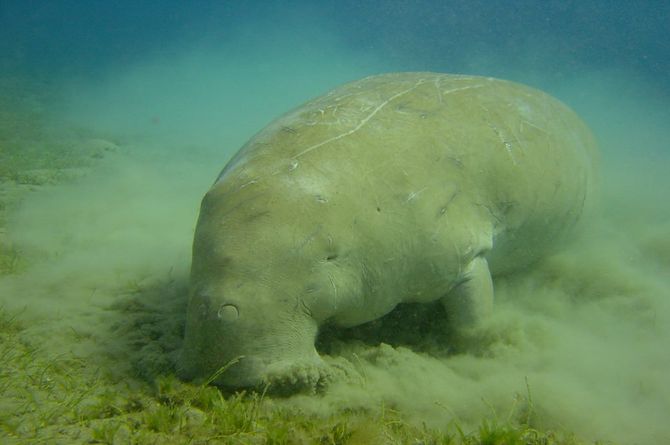Our amazing creatures. Part 1: The Dugong
As a part of our promise to bring science to your doorstep, we will introduce to you in a series of articles about our amazing creatures in the Red Sea, simple information about them and why it is important to protect them. We start our series with one of our most fascinating sea creature in our waters: the Dugong. The term dugong itself is driven from an old Indonesian language meaning “The Lady of the sea”. The dugong is a large marine mammal that is considered to be the last living example of once a very diverse marine mammal’s family. Its closest relative, the Stellers sea cow, is a modern text book example of extinction due to overfishing. It took only 27 years from its discovery by western civilization through Russian sailors in 1741 when the first Stellers sea cow was killed for food, to its extinction in 1768 when sailors killed the last one. A remarkable species, possibly the largest herbivores species ever existed in the marine habitat was lost forever. Dugongs, its closest and smaller relative, are considered endangered in all their habitat range. The dugong is currently the largest herbivores on the Red Sea environment depending mainly on sea grass as a main diet. The dugong is characterized by a sharply downturned snout, a special adaptation that helps in grazing and uprooting sea grasses. A remarkable molecular study showed that the dugong is more related to elephant than any other marine mammals. They are very shy and do not approach humans, they are usually solitary or found in pairs on sea grass beds. They spend most of their lives in shallow water; they have the ability to produce sound under the water as they communicate through chirps and whistles. During their reproductive season males fights for females, the most common courtship technique used sees the female swimming and more than one male following her, fighting in the attempt to mate with her, inflecting injuries to the female and each other. In this case the female might copulate with more than one male. Females carry one calf and give birth after a gestation period of 12-15 month. Birth occurs in very shallow water, in some occasions almost on shore to avoid calf drowning. Once the calf is born the mother pushes him to surface to breath. The calf’s length range from 1 to 1.2 m and weight around 30 kg, the nursing time for the newborn ranges from 14-18 month, however the newborn feeds on seagrass too. Only once matured the calf leaves the mother. The IUCN lists the dugong as a species vulnerable to extinction and the CITES limits any trade in products that are derived from dugong. The main causes for population declines are hunting, increased boat trafficking in shallow areas and habitat degradation. The ecological importance of dugong is coming from their herbivores feeding habits as sea grasses are similar to land grass: if not cut down from time to time their productivity will decrease. The economical importance of the dugong is coming from it being a rare species, a last of a kind. The presence of dugong in the Egyptian coast of the Red Sea is a privilege for Egypt, with tourist coming especially to see an amazing creature that is rarely seen anywhere else. To help protect the dugongs in the Red Sea, we have to protect our sea grass ecosystem and try to stop or at least minimize speed boat trafficking in shallow waters. Moreover, since human impact from snorkelers and divers can seriously disturb the animals, we invite guides and tourists to keep a respectful behaviour in the water: keep a distance, do not chase the dugong and leave it the space needed in the water column to safely and calmly surface to breath. Do not stand in front of it, observe it quietly from a side instead. Don’t touch it. If you witness bad behaviours, please report it to HEPCA



